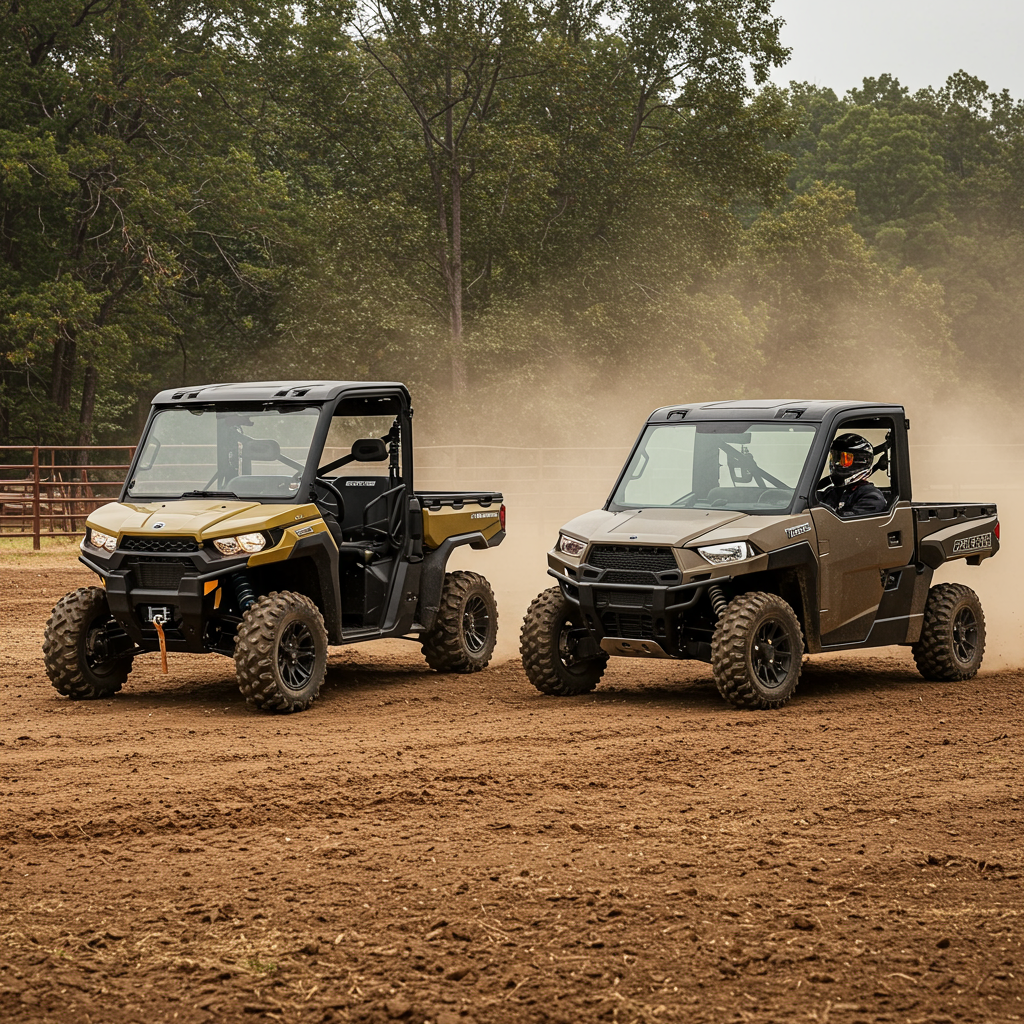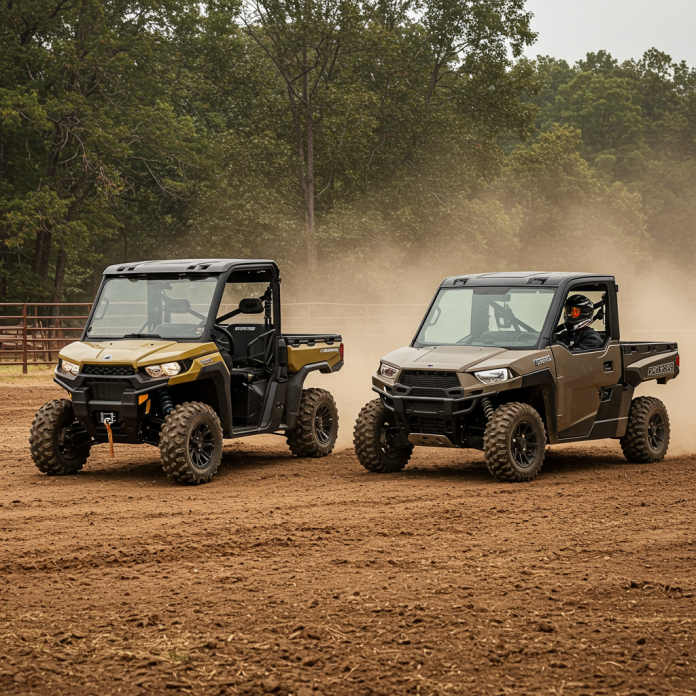The sun hasn’t yet crested the ridge, but the day’s work has already begun. Whether you’re loading feed on the farm, checking fences across a sprawling ranch, or mapping out the perfect spot for a deer stand deep in the woods, your utility task vehicle (UTV) isn’t a toy—it’s your most trusted partner. It’s the first tool you reach for in the morning and the last one you park at night.
When you rely on a machine this heavily, the choice of brand and model becomes critical. For most serious users, that choice inevitably boils down to two titans of the industry: the Can-Am Defender and the Polaris Ranger.

Both are legends, forged in mud and proven over countless hours of hard labor. But while they often compete for the same jobs, they are born from different philosophies. One champions refined engineering and operator comfort; the other prides itself on rugged simplicity and battlefield-tested toughness. So, which one is the right long-term investment for you?
Let’s cut through the marketing noise and get to the heart of it. This is a no-fluff, deep-dive comparison to help you make a truly informed decision.
Quick Specs Comparison
At a glance, the spec sheets for their most popular models tell a story of two closely matched competitors.
| Feature | Can-Am Defender HD10 / MAX | Polaris Ranger XP 1000 / Crew |
| Engine | Rotax 976cc V-Twin | ProStar 999cc Parallel-Twin |
| Horsepower | 82 hp (HD10) | 82 hp (XP 1000) |
| Towing Capacity | 2,500 lbs (1,134 kg) | 2,500 lbs (1,134 kg) |
| Payload Capacity | 1,750 lbs (793 kg) – Varies by specific model | 1,500 lbs (680 kg) |
| Ground Clearance | 12-14 inches | 13-14 inches |
| Seating | 3-6 seats | 3-6 seats |
As you can see, the numbers are nearly neck-and-neck. Horsepower and towing capacity are identical. This is where most comparisons stop, but it’s where the real differences begin to emerge. The soul of these machines lies not in the numbers, but in how they deliver on their promises in the real world.
Key Comparison Factors: Where the Battle is Won and Lost
1. Performance & Powertrain: The Heart of the Beast
Can-Am Defender:
The Defender is powered by the legendary Rotax V-Twin engine. If you’ve ever been around Can-Am products, you know the Rotax name is synonymous with smooth, responsive power. In the Defender, it’s tuned for low-end torque and a remarkably quiet operation. It doesn’t scream; it hums with confidence. This refined power delivery is ideal for tasks requiring precision—like backing a trailer into a tight spot or navigating near livestock without causing a stir.
The real magic, however, is in the drivetrain. The Pro-Torq transmission is incredibly smooth, and the available Smart-Lok front differential is a technological marvel. Instead of a simple locking mechanism, Smart-Lok uses advanced sensors to automatically adjust torque to the wheel with the most grip, before you even realize you need it. Picture this: you’re crossing a muddy, rutted-out section of your property. The Defender’s system predicts wheel slip and sends power exactly where it needs to go, pulling you through with drama-free composure.
- Best for: Heavy towing, precision maneuvers, and operators who value a quiet, refined powertrain that reduces fatigue over a long workday.
Polaris Ranger:
The Ranger counters with its ProStar parallel-twin engine. The ProStar is a legend for a different reason: it is a proven, battle-hardened workhorse. It has a slightly more aggressive, utilitarian growl and feels eager to get to work. It’s less about finesse and more about sheer, unadulterated grit. For years, this engine has powered everything from workhorses to trail monsters, earning a reputation for near-indestructible reliability.
The Ranger’s On-Demand True AWD system is the definition of simple and effective. It remains in 2WD for efficiency until the rear wheels slip, at which point it instantly engages the front wheels to provide all-wheel drive. The VersaTrac Turf Mode is a standout feature, unlocking the rear differential to allow for tighter turns without tearing up your lawn or pasture—a crucial feature for property owners.
- Best for: Hunters, property owners, and anyone who needs a no-nonsense, bulletproof powertrain that has proven itself over millions of hours in the field.
Verdict: It’s a classic trade-off. The Defender’s powertrain is the more modern, smooth, and intelligent system. The Ranger’s is the simpler, more rugged, and time-tested veteran.
2. Ride Comfort & Cab Experience: Your Office for the Day
Can-Am Defender:
This is arguably the Defender’s strongest category. Can-Am has poured immense effort into creating the most comfortable cab in the utility segment. The suspension is tuned for a plush ride, absorbing bumps and ruts with automotive-like grace. The seats are well-bolstered, the steering is light, and the overall fit and finish feel a step above.
But the real game-changer is noise reduction. The engine is mounted further back, and extensive insulation is used throughout the chassis and firewall. The result is one of the quietest UTVs on the market, allowing for normal conversations without shouting. On premium models like the Defender Limited, you get a fully sealed cab with factory-installed heating and air conditioning, effectively turning your UTV into a mobile office, sealed away from a sweltering August afternoon or a biting November wind.
Polaris Ranger:
The Ranger’s ride is firm and capable, but it’s undeniably built with utility as the first priority, not luxury. The suspension is robust and designed to handle heavy loads without complaint, but it transmits more of the trail’s imperfections to the cabin. The cab is functional and well-laid-out, with plenty of storage, but it doesn’t have the same level of refinement or noise suppression as the Defender.
That said, Polaris knows its customers. The NorthStar Edition is their answer to the Defender Limited, also offering a premium, factory-installed HVAC system. While the cab may be slightly louder and the ride a bit firmer than the Defender’s, the NorthStar’s climate control is powerful and highly effective, making it a sanctuary in extreme weather.
Verdict: If all-day comfort is your number one priority, the Can-Am Defender is the undisputed winner. Its quietness and ride quality significantly reduce operator fatigue. The Ranger is plenty capable but is built with a toughness-first ethos that places comfort as a secondary, albeit important, consideration.
3. Work Capabilities: Getting the Job Done
Towing & Hauling:
While both are rated to tow 2,500 lbs, the feeling under load can differ. The Defender’s smooth V-Twin torque application feels exceptionally controlled when starting a heavy load. Critically, the Defender boasts a higher payload capacity in its bed, allowing you to haul more material in a single trip.
Cargo Bed & Storage:
The Ranger’s cargo bed is a simple, no-frills composite box that is incredibly durable and easy to wash out. It’s a purely utilitarian design.
The Defender’s bed is equally tough but incorporates more clever features, like integrated recesses for 5-gallon buckets and optional dividers. Where Can-Am truly excels is in-cab storage. The Defender’s dash is a masterpiece of functionality, featuring a massive, removable waterproof toolbox and multiple compartments.
Attachments & Versatility:
This is where the Ranger claws back a major advantage. Polaris’s Lock & Ride system is arguably the most mature and extensive attachment ecosystem on the market. From plows and winches to gun racks and purpose-built tool holders, the sheer volume of both Polaris-branded and aftermarket accessories for the Ranger is staggering. This makes it incredibly easy to customize the machine for any specific job you can imagine. Can-Am’s LinQ system is excellent and growing, but the aftermarket support for Polaris remains broader.
Verdict: For pure, heavy-duty hauling, the Defender’s higher payload gives it a slight edge. For overall versatility and ease of customization with attachments, the Polaris Ranger holds a clear advantage due to its vast aftermarket ecosystem.
4. Durability & Long-Term Ownership
Can-Am Defender:
The Defender is built on a robust, automotive-inspired frame. The engineering feels polished and modern. In recent years, Can-Am has made significant strides in reliability, and owner forums report strong satisfaction with the vehicle’s build quality. Dealer support is strong, though the network isn’t quite as vast as Polaris’s in some rural areas. Maintenance points are generally accessible.
Polaris Ranger:
The Ranger’s frame and components have an almost agricultural feel to them—thick, sturdy, and built to be abused. While some older models faced complaints about minor issues like plastics or bushings, the current generation is widely regarded as rock-solid. The primary advantage for Polaris is its massive dealer network. No matter how remote your location, you’re likely to be closer to a Polaris dealer, making parts and service more accessible. This is a significant logistical advantage for those who can’t afford downtime.
Verdict: Both are highly reliable machines built for years of service. The Defender feels more like a modern, precisely engineered truck, while the Ranger feels like a timeless, overbuilt tractor. The Ranger’s larger dealer network gives it an edge in serviceability for users in remote locations.
Final Recommendation: Who Should Buy Which?
After laying out all the facts, the choice comes down to your personal priorities and philosophy. There is no single “best” UTV, only the one that is best for you.
Choose the Can-Am Defender if you…
- Are a modern farmer or rancher who spends long hours in the cab and values comfort as a tool to reduce fatigue and increase productivity.
- Need the absolute maximum payload capacity for hauling feed, tools, or materials.
- Want the quietest, most refined ride to inspect livestock, talk with a passenger easily, or simply enjoy a more peaceful work environment.
- View your UTV as a long-term investment in premium features, such as a fully-sealed HVAC cab that feels like a modern pickup truck.
Choose the Polaris Ranger if you…
- Are a budget-conscious property owner or hunter who wants proven, straightforward reliability at a more accessible price point.
- Need the widest possible selection of aftermarket parts and accessories to customize your machine for very specific tasks (hunting, ice fishing, trail maintenance).
- Prioritize simple, rugged mechanics and the peace of mind that comes with the largest dealer network for service and parts.
- Use your UTV for a mix of hard work and recreation, and want a machine that feels just as capable on the trail as it does on the job site.
The Bottom Line
There is no wrong choice here. Buying either a Can-Am Defender or a Polaris Ranger means you are getting an outstanding, top-tier utility vehicle. The decision hinges on this fundamental difference:
- Defender = Refined Performance. It’s the modern workhorse, prioritizing comfort, quietness, and smart technology to make the toughest jobs feel easier.
- Ranger = Proven Toughness. It’s the traditional workhorse, prioritizing affordability, versatility, and a simple, rugged design that has been trusted for decades.
Still unsure? There is no substitute for seat time. The best way to decide is to test drive both. Feel the difference in the suspension. Listen to the engine. Sit in the cab and imagine yourself working in it for eight hours. One of them will almost certainly feel right for you and the work you need to do.
Got questions? Drop them in the comments, or check out more UTV comparisons at utvauto.com.
